Study of Photovoltaic Double-Skin Façade Windows in Passenger Ships
Abstract
1. Introduction
2. Theoretical Models
- (1)
- Only the change in temperature of each part of the vertical direction was considered.
- (2)
- Heat transfer between the window section and the frame was ignored.
- (3)
- None of the thermal parameters in the system varied with temperature.
- (4)
- Solar radiation did not enter the room through the PV-DSF model.
- (5)
- The electrical efficiency of photovoltaic cells did not decrease when the temperature rose.
- (6)
- Physical properties were steady.
2.1. Solar Radiation
2.2. PV Glass
2.3. Air Channel
2.4. Glass
3. Experimental Setup
4. Model Validation
5. Results and Discussion
5.1. Solar Radiation Intensity
5.2. Ambient Temperature
5.3. Wind Speed
5.4. PV Coverage Ratio
5.5. Energy Analysis
6. Conclusions
- (1)
- Solar radiation intensity, as the main input energy source, played a decisive role in the thermoelectric performance of the whole PV-DSF model. This was manifested by the positive correlation trend between solar radiation intensity and temperature and power generation.
- (2)
- Ambient temperature was an important influence on the heat exchange between the system and its surroundings. When the ambient temperature increased, the overall temperature of the PV-DSF model also increased significantly because of the heat exchange. However, as the temperature of the PV glass increased, the power generation tended to decrease, from about 22.5 W to 20 W, which was a decrease of 11%.
- (3)
- Wind speed had a negatively correlated effect on the thermal performance of the PV-DSF model. The wind speed had a strong effect on the temperature of the outer glass, while it had little effect on the inner glass. As wind speed continued to increase, the model’s power generation increased slightly, from about 21.4 W to 22 W, an increase of about 3%. It was worth noting that there would be an upper limit to the effect of wind speed on the overall performance of the model, as evidenced by the fact that the performance of the system changed less and less as the wind speed continued to increase.
- (4)
- There was a direct link between the PV coverage and the electrical performance of the PV-DSF model. As the PV coverage increased, the power generation also increased from about 3 W to 24 W, an increase of 700%. The thermal impact on the outer glass layer was much greater than the inner glass layer due to PV light absorption.
- (5)
- The PV-DSF system was installed in the ship’s right, left and rear windows to provide a total of 53.2 kwh of annual electricity generation and a reduction of 17 kg of CO2 emissions.
Author Contributions
Funding
Institutional Review Board Statement
Informed Consent Statement
Data Availability Statement
Conflicts of Interest
Nomenclature
| Symbol | |
| Solar radiation, W/m2 | |
| Inclined angle, ° | |
| Reflectance coefficient | |
| Incidence angle, ° | |
| Zenith angle, ° | |
| Thickness, m | |
| Density, kg/m3 | |
| K | |
| K | |
| Temperature, °C | |
| Absorptivity | |
| K | |
| Wind speed, m/s | |
| Emissivity | |
| K4 | |
| Nusselt number | |
| K | |
| Depth, m | |
| PV coverage ratio | |
| Transmittance | |
| Electrical efficiency | |
| Electrical efficiency | |
| Temperature coefficient | |
| Gravity constant, m/s2 | |
| Volumetric expansion coefficient | |
| Height, m | |
| Hydraulic diameter, m | |
| Area, m2 | |
| Loss coefficient | |
| Subscripts | |
| Beam radiation | |
| Diffuse reflection | |
| Reflected radiation | |
| PV glass | |
| Outdoor air | |
| Radiation | |
| Clear glass | |
| Air in the channel | |
| Outlet of the air channel | |
| Inlet of the air channel | |
| Air channel | |
| Indoor air | |
References
- Ivanova, G.; IEEE. Ways to Increase the Efficiency of a Ship Cooling System. In Proceedings of the 13th Electrical Engineering Faculty Conference (BulEF), Varna, Bulgaria, 8–11 September 2021. [Google Scholar]
- Xie, P.L.; Tan, S.; Guerrero, J.M.; Vasquez, J.C. MPC-informed ECMS based real-time power management strategy for hybrid electric ship. Energy Rep. 2021, 7, 126–133. [Google Scholar] [CrossRef]
- Wang, W.; Liu, Y.N.; Zhen, L.; Wang, H. How to Deploy Electric Ships for Green Shipping. J. Mar. Sci. Eng. 2022, 10, 18. [Google Scholar] [CrossRef]
- Otsason, R.; Tapaninen, U. Decarbonizing City Water Traffic: Case of Comparing Electric and Diesel-Powered Ferries. Sustainability 2023, 15, 16170. [Google Scholar] [CrossRef]
- Ni, J.; Li, J.; An, W.; Zhu, T. Performance analysis of nanofluid-based spectral splitting PV/T system in combined heating and power application. Appl. Therm. Eng. 2018, 129, 1160–1170. [Google Scholar] [CrossRef]
- Yigit, K.; Acarkan, B. A new ship energy management algorithm to the smart electricity grid system. Int. J. Energy Res. 2018, 42, 2741–2756. [Google Scholar] [CrossRef]
- Lv, S.; Zhang, M.M.; Lai, Y.; Wu, Y.Y.; Deng, J.C.; Guo, Y.; Feng, M.Q.; Shi, G.Q.; Zhang, B.L.; Ren, J.W.; et al. Comparative analysis of photovoltaic thermoelectric systems using different photovoltaic cells. Appl. Therm. Eng. 2023, 235, 11. [Google Scholar] [CrossRef]
- Glykas, A.; Papaioannou, G.; Perissakis, S. Application and cost-benefit analysis of solar hybrid power installation on merchant marine vessels. Ocean Eng. 2010, 37, 592–602. [Google Scholar] [CrossRef]
- Lan, H.; Wen, S.L.; Hong, Y.Y.; Yu, D.C.; Zhang, L.J. Optimal sizing of hybrid PV/diesel/battery in ship power system. Appl. Energy 2015, 158, 26–34. [Google Scholar] [CrossRef]
- Tang, R.L. Large-scale photovoltaic system on green ship and its MPPT controlling. Sol. Energy 2017, 157, 614–628. [Google Scholar] [CrossRef]
- Zhang, Y.; Yuan, C.Q. Effects of marine environment on electrical output characteristics of PV module. J. Renew. Sustain. Energy 2021, 13, 9. [Google Scholar] [CrossRef]
- Ghenai, C.; Bettayeb, M.; Brdjanin, B.; Hamid, A.K. Hybrid solar PV/PEM fuel Cell/Diesel Generator power system for cruise ship: A case study in Stockholm, Sweden. Case Stud. Therm. Eng. 2019, 14, 9. [Google Scholar] [CrossRef]
- Kurniawan, A.; Shintaku, E. Determining the optimal inclination and orientation angles of solar panels installed on ship. Int. J. Renew. Energy Res. 2020, 10, 45–53. [Google Scholar]
- Karatug, C.; Durmusoglu, Y. Design of a solar photovoltaic system for a Ro-Ro ship and estimation of performance analysis: A case study. Sol. Energy 2020, 207, 1259–1268. [Google Scholar] [CrossRef]
- Wen, S.L.; Lan, H.; Yu, D.C.; Fu, Q.; Hong, Y.Y.; Yu, L.J.; Yang, R.R. Optimal sizing of hybrid energy storage sub-systems in PV/diesel ship power system using frequency analysis. Energy 2017, 140, 198–208. [Google Scholar] [CrossRef]
- Sun, Y.W.; Yan, X.P.; Yuan, C.Q.; Tang, X.J.; Malekian, R.; Guo, C.; Li, Z.X. The application of hybrid photovoltaic system on the ocean-going ship: Engineering practice and experimental research. J. Mar. Eng. Technol. 2019, 18, 56–66. [Google Scholar] [CrossRef]
- Wang, C.Y.; Uddin, M.M.; Ji, J.; Yu, B.D.; Wang, J. The performance analysis of a double-skin ventilated window integrated with CdTe cells in typical climate regions. Energy Build. 2021, 241, 17. [Google Scholar] [CrossRef]
- Zhou, J.; Chen, Y.M. A review on applying ventilated double-skin facade to buildings in hot-summer and cold-winter zone in China. Renew. Sust. Energ. Rev. 2010, 14, 1321–1328. [Google Scholar] [CrossRef]
- Han, J.; Lu, L.; Peng, J.Q.; Yang, H.X. Performance of ventilated double-sided PV facade compared with conventional clear glass facade. Energy Build. 2013, 56, 204–209. [Google Scholar] [CrossRef]
- Yoon, J.H.; Shim, S.R.; An, Y.S.; Lee, K.H. An experimental study on the annual surface temperature characteristics of amorphous silicon BIPV window. Energy Build. 2013, 62, 166–175. [Google Scholar] [CrossRef]
- Olivieri, L.; Caamano-Martin, E.; Moralejo-Vazquez, F.J.; Martin-Chivelet, N.; Olivieri, F.; Neila-Gonzalez, F.J. Energy saving potential of semi-transparent photovoltaic elements for building integration. Energy 2014, 76, 572–583. [Google Scholar] [CrossRef]
- Olivieri, L.; Caamano-Martin, E.; Olivieri, F.; Neila, J. Integral energy performance characterization of semi-transparent photovoltaic elements for building integration under real operation conditions. Energy Build. 2014, 68, 280–291. [Google Scholar] [CrossRef]
- Chae, Y.T.; Kim, J.; Park, H.; Shin, B. Building energy performance evaluation of building integrated photovoltaic (BIPV) window with semi-transparent solar cells. Appl. Energy 2014, 129, 217–227. [Google Scholar] [CrossRef]
- Peng, J.Q.; Curcija, D.C.; Lu, L.; Selkowitz, S.E.; Yang, H.X.; Zhang, W.L. Numerical investigation of the energy saving potential of a semi-transparent photovoltaic double-skin facade in a cool-summer Mediterranean climate. Appl. Energy 2016, 165, 345–356. [Google Scholar] [CrossRef]
- Elarga, H.; Zarrella, A.; De Carli, M. Dynamic energy evaluation and glazing layers optimization of facade building with innovative integration of PV modules. Energy Build. 2016, 111, 468–478. [Google Scholar] [CrossRef]
- Wang, C.Y.; Ji, J.; Uddin, M.M.; Yu, B.D.; Song, Z.Y. The study of a double-skin ventilated window integrated with CdTe cells in a rural building. Energy 2021, 215, 17. [Google Scholar] [CrossRef]
- Chow, T.T.; Fong, K.F.; He, W.; Lin, Z.; Chan, A.L.S. Performance evaluation of a PV ventilated window applying to office building of Hong Kong. Energy Build. 2007, 39, 643–650. [Google Scholar] [CrossRef]
- Wang, C.Y.; Li, N.S.; Yu, B.D.; Uddin, M.M.; Ji, J. A novel solar spectrum-splitting utilization photocatalytic CdTe double-skin facade: Concept, design and performance investigation. Build. Environ. 2021, 195, 16. [Google Scholar] [CrossRef]
- Duffie, J.A.; Beckman, W.A. Solar Engineering of Thermal Processes; Meteorological Data; John Wiley & Sons, Inc.: Hoboken, NJ, USA, 2013; pp. 863–869. [Google Scholar] [CrossRef]
- Li, G.Q.; Zhao, X.D.; Ji, J. Conceptual development of a novel photovoltaic-thermoelectric system and preliminary economic analysis. Energy Conv. Manag. 2016, 126, 935–943. [Google Scholar] [CrossRef]
- Ong, K.S.; Chow, C.C. Performance of a solar chimney. Sol. Energy 2003, 74, 1–17. [Google Scholar] [CrossRef]
- Khalvati, F.; Omidvar, A. Summer study on thermal performance of an exhausting airflow window in evaporatively-cooled buildings. Appl. Therm. Eng. 2019, 153, 147–158. [Google Scholar] [CrossRef]
- Jle, J.; Hua, Y.; Wei, H.; Gang, P.; Lu, J.P.; Bin, J. Modeling of a novel Trombe wall with PV cells. Build. Environ. 2007, 42, 1544–1552. [Google Scholar] [CrossRef]
- Skoplaki, E.; Palyvos, J.A. On the temperature dependence of photovoltaic module electrical performance: A review of efficiency/power correlations. Sol. Energy 2009, 83, 614–624. [Google Scholar] [CrossRef]
- Jie, J.; Bin, J.; Huai, Y.; Tin-Tai, C.; Wei, H.; Gang, P. An experimental and mathematical study of efforts of a novel photovoltaic-Trombe wall on a test room. Int. J. Energy Res. 2008, 32, 531–542. [Google Scholar] [CrossRef]
- Khalifa, A.; Marshall, R.H. Validation of heat transfer coefficients on interior building surfaces using a real-sized indoor test cell. Int. J. Heat Mass Transf. 1990, 33, 2219–2236. [Google Scholar] [CrossRef]
- Xu, L.J.; Luo, K.; Ji, J.; Yu, B.D.; Li, Z.M.; Huang, S.J. Study of a hybrid BIPV/T solar wall system. Energy 2020, 193, 401–415. [Google Scholar] [CrossRef]
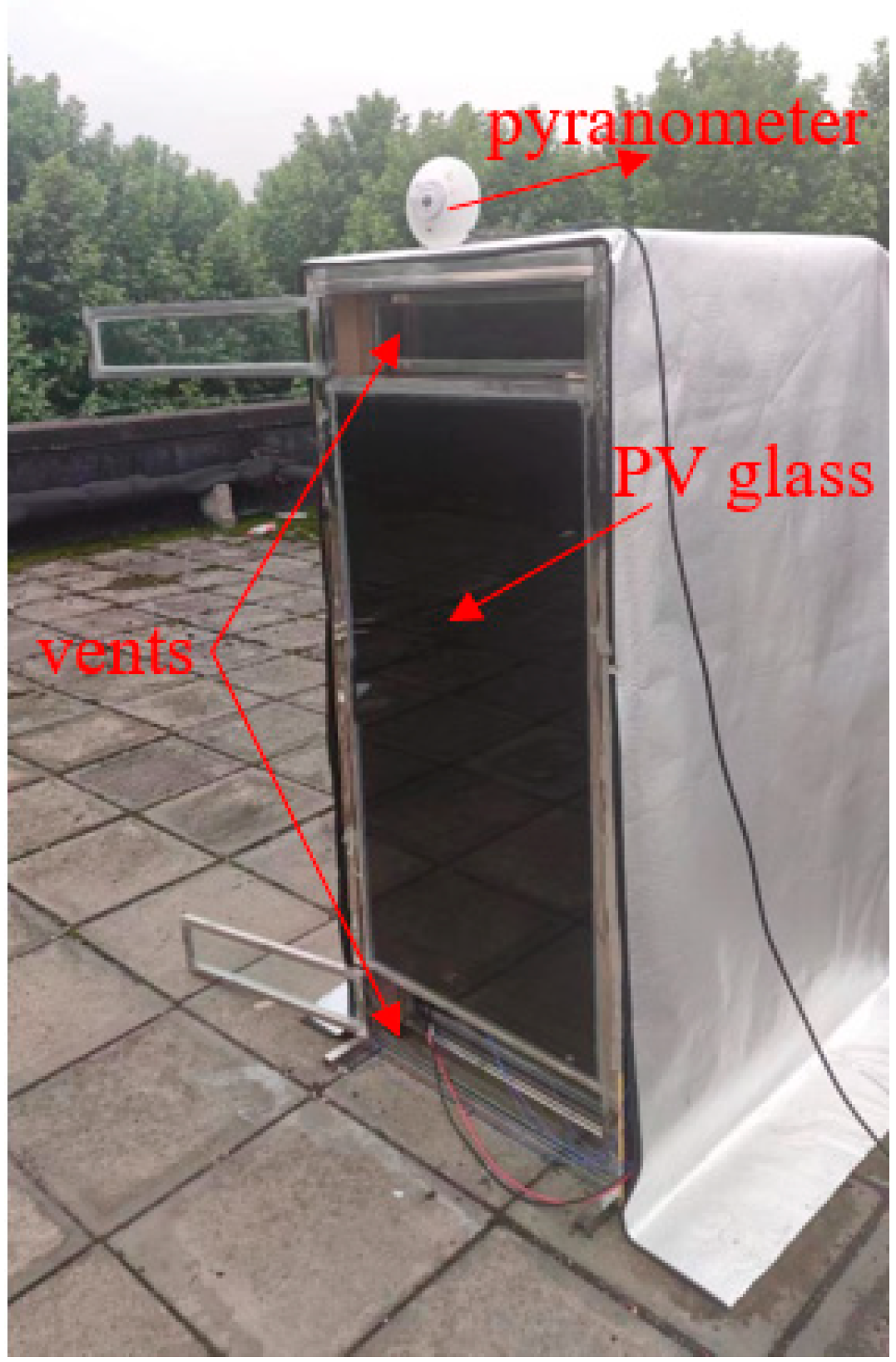
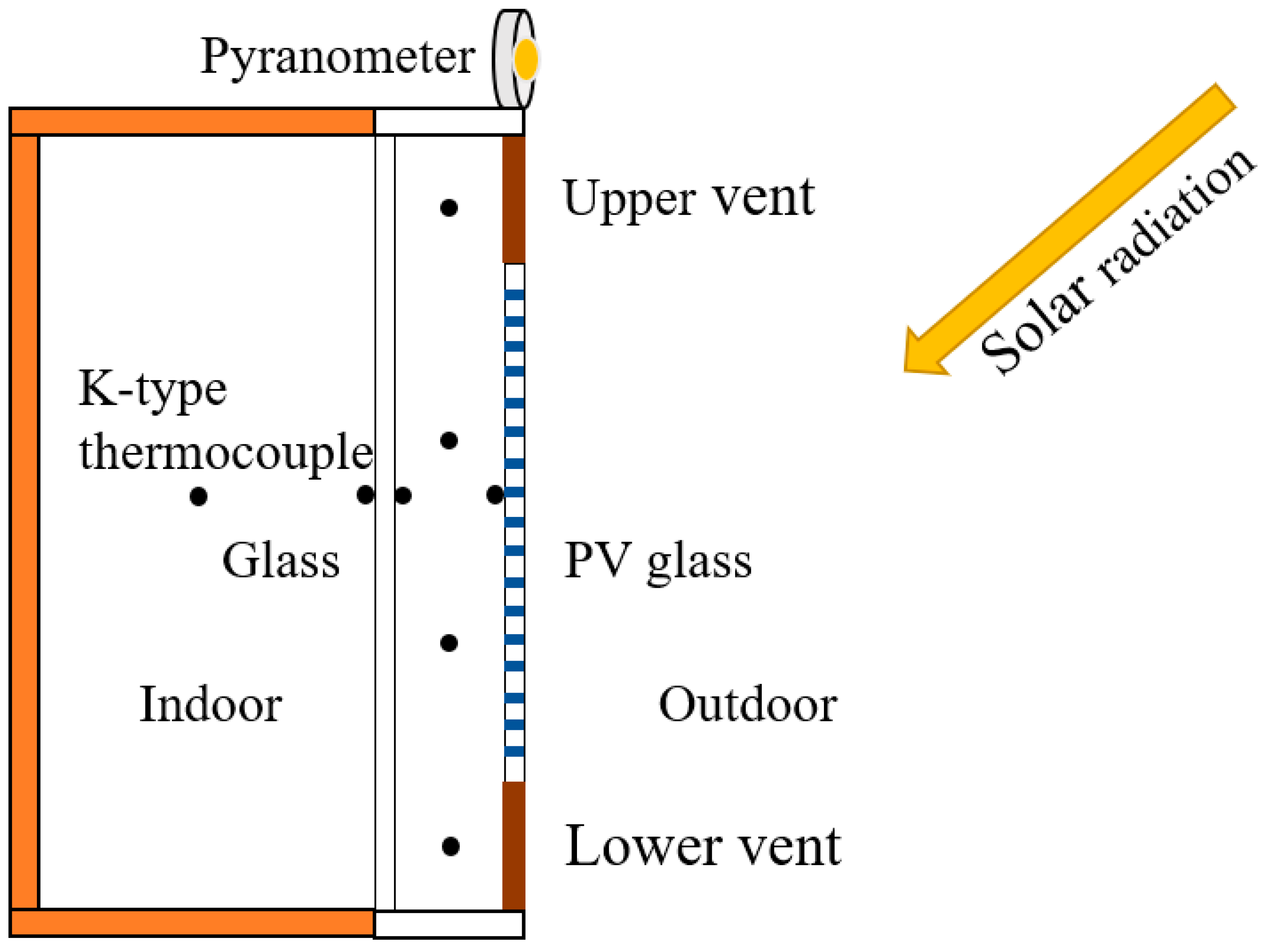



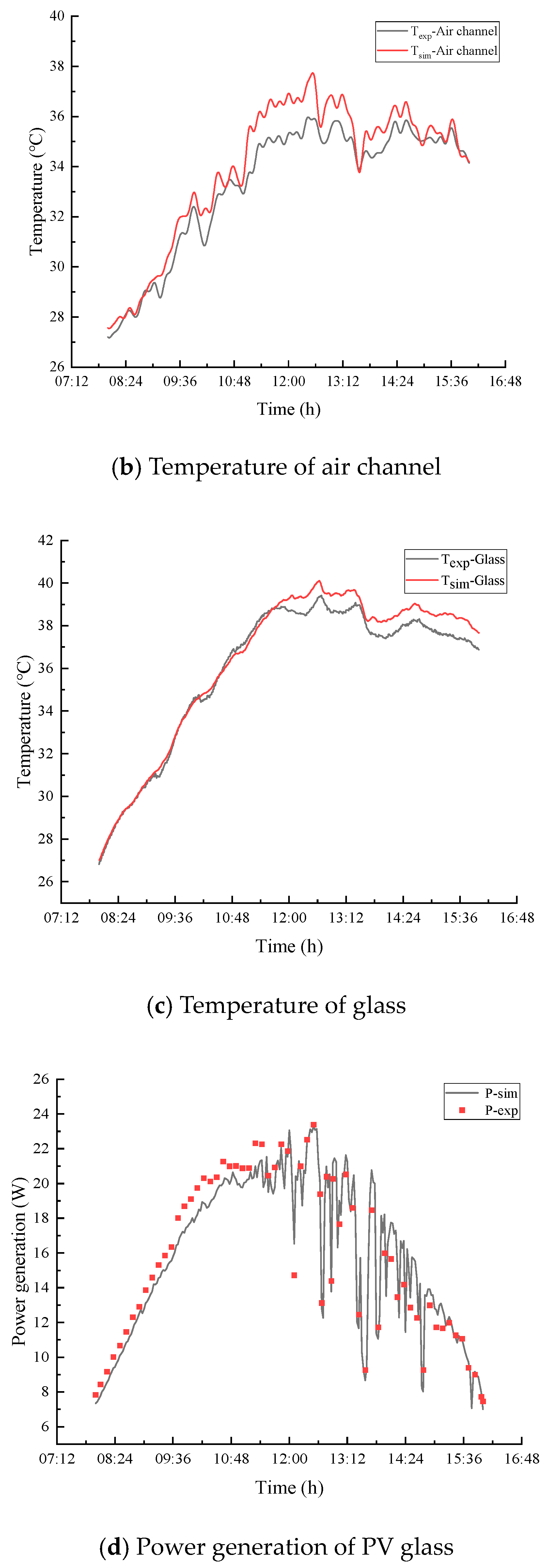

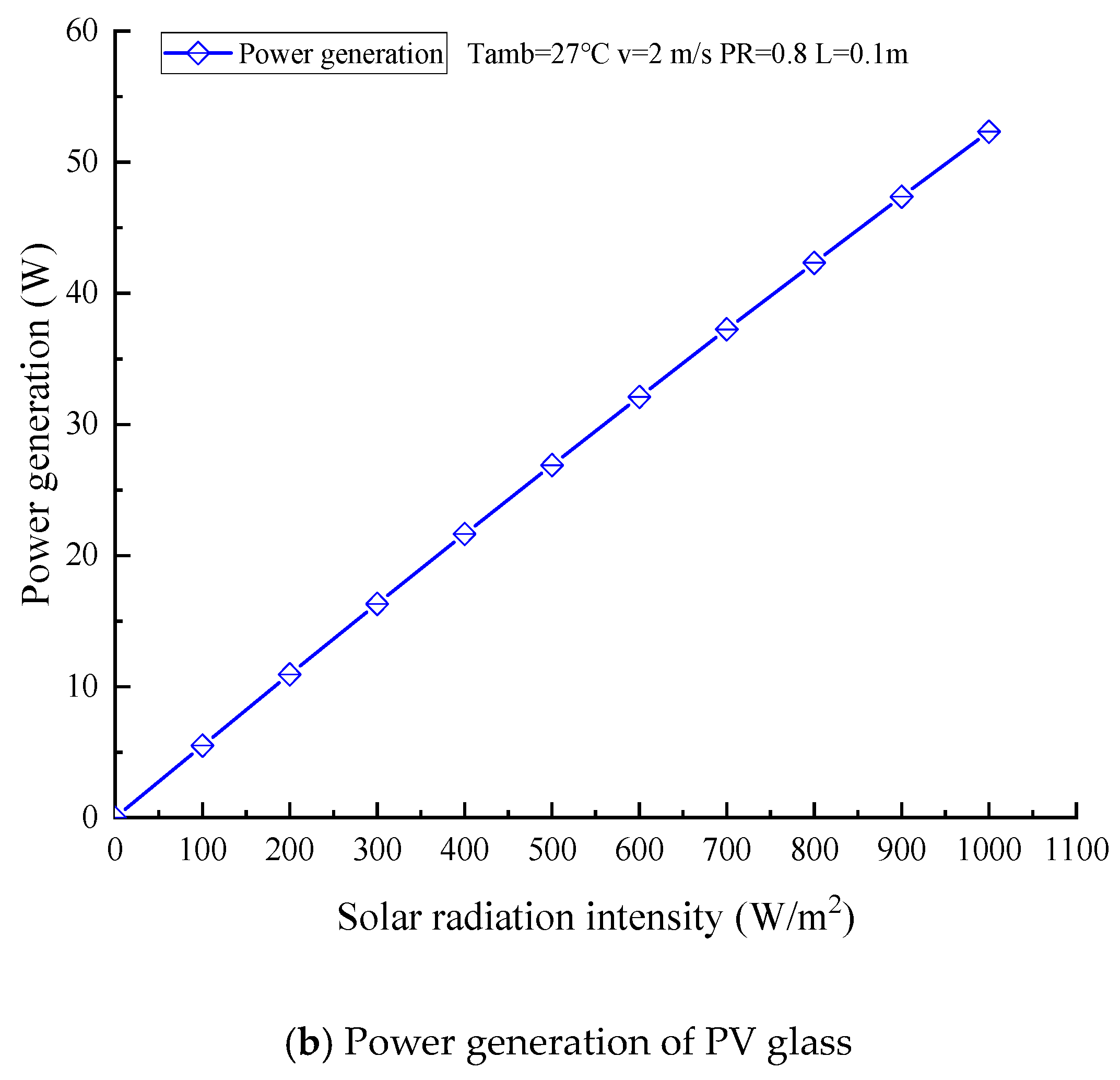
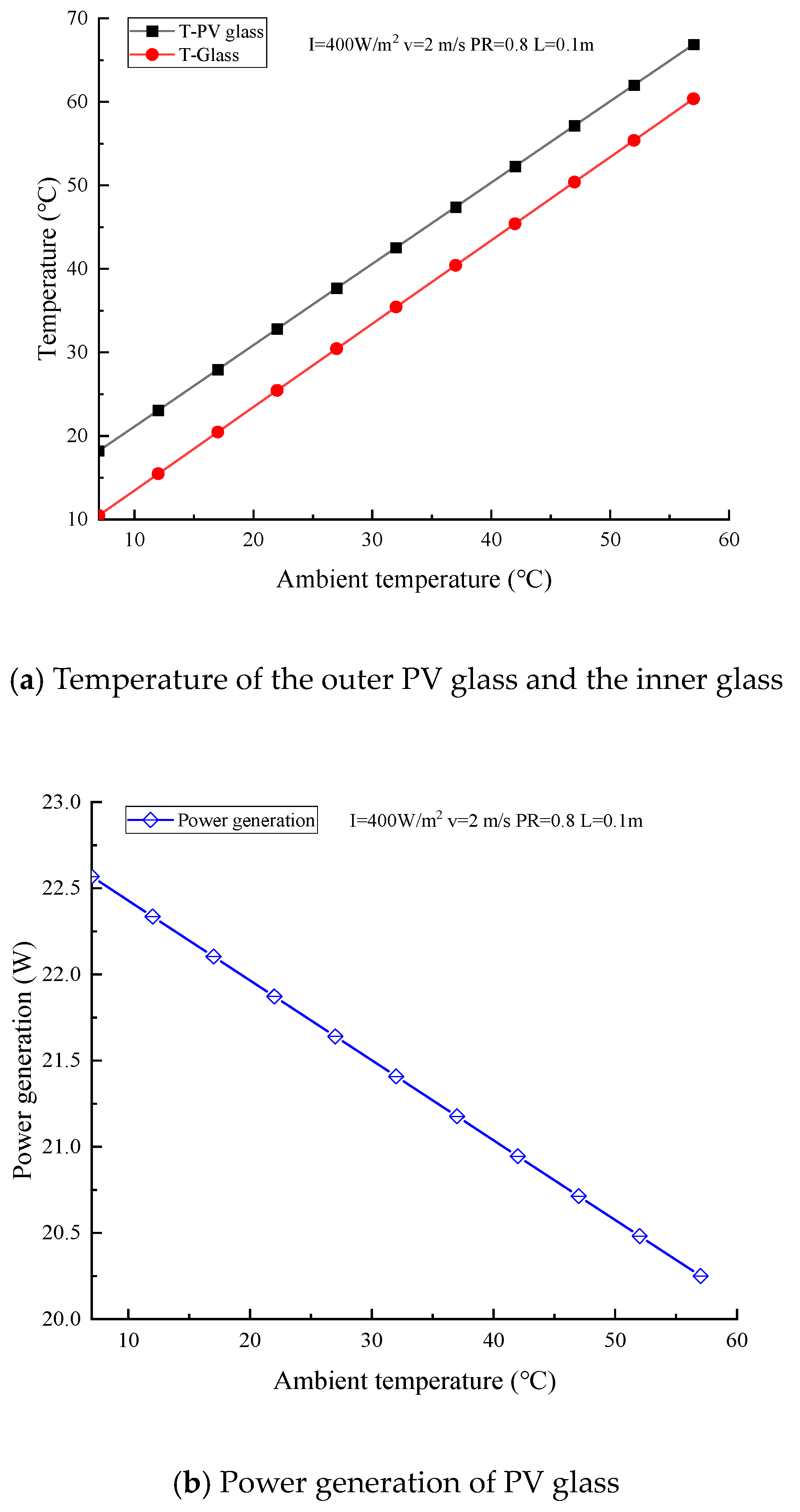
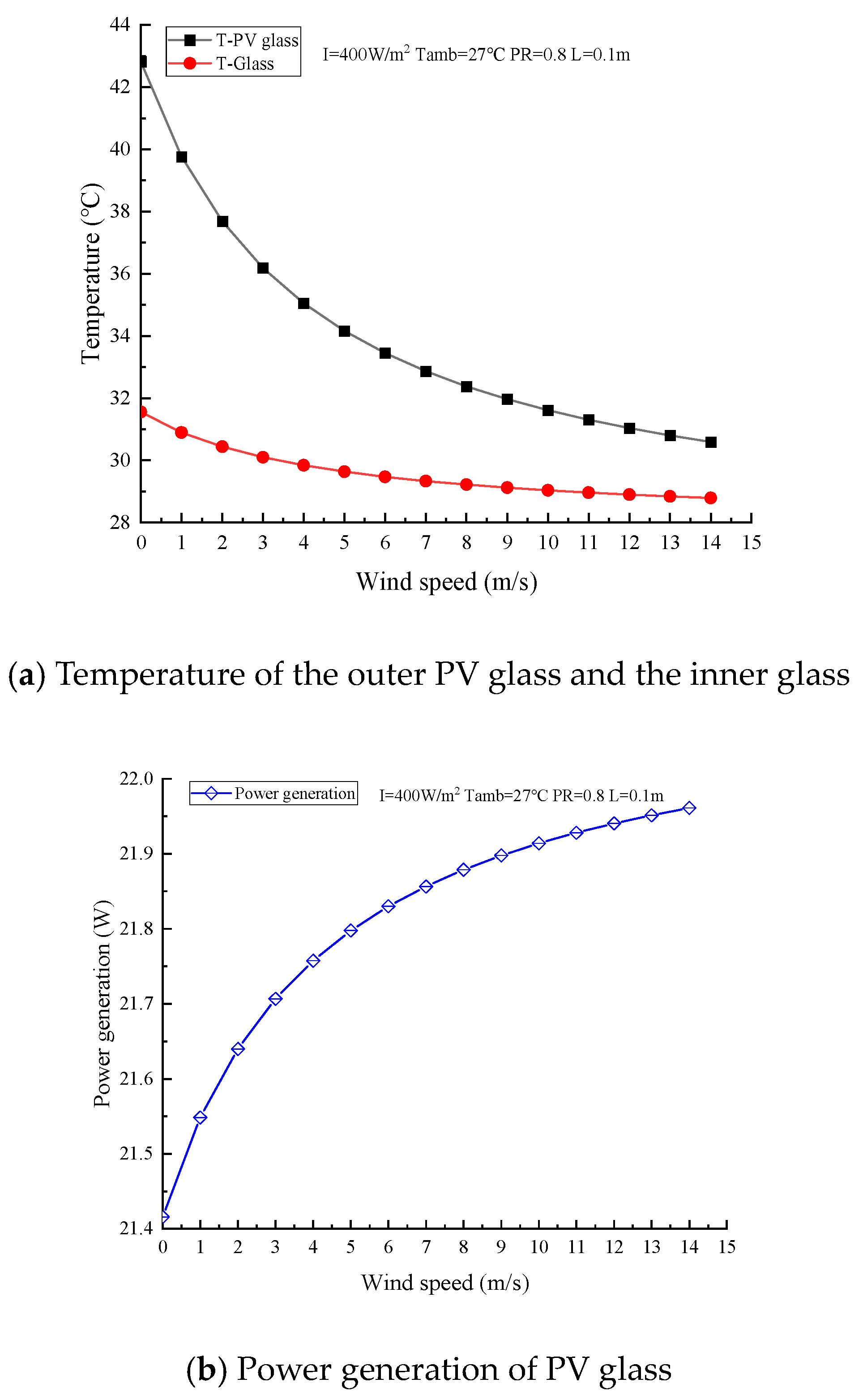
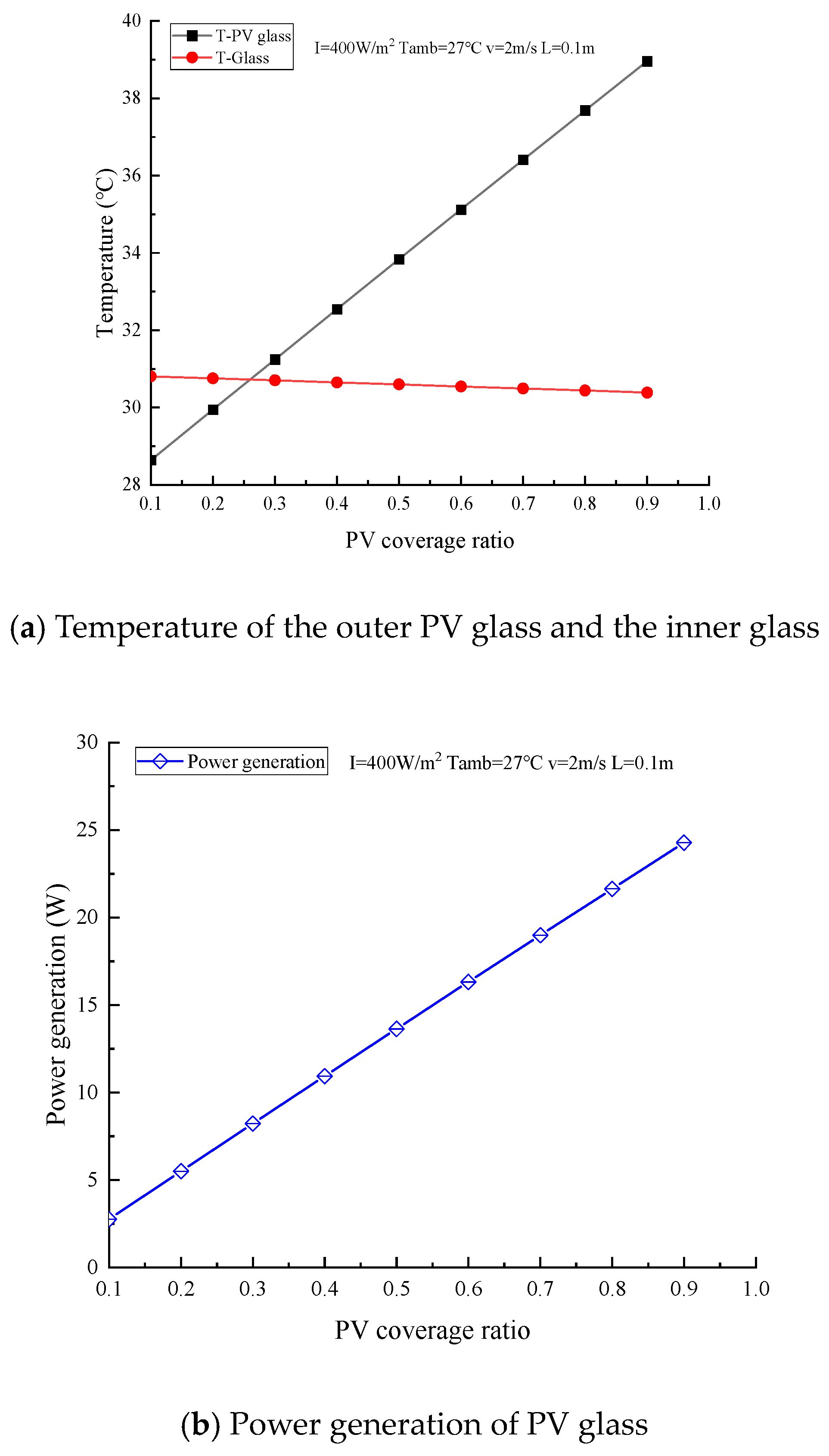

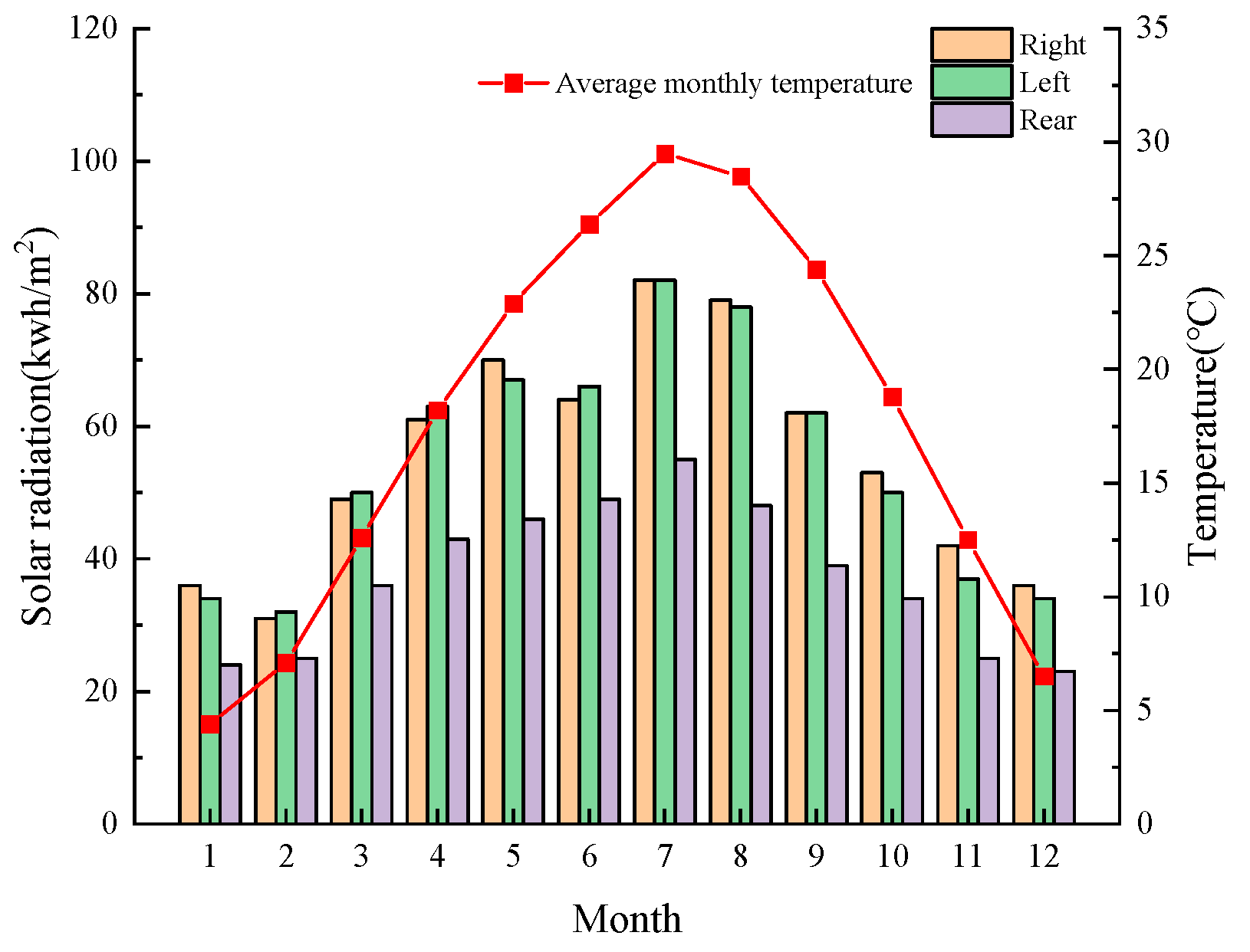

| Parameters | Values |
|---|---|
| Maximum power (Em) | 76 (W) |
| Open circuit voltage (Voc) | 122.5 (V) |
| Short circuit current (Isc) | 0.98 (A) |
| Voltage at maximum power point (Vmp) | 89.7 (V) |
| Current at maximum power point (Imp) | 0.85 (A) |
| PV module efficiency | 10.56% |
| Temperature coefficient of Voc | −0.321%/°C |
| Temperature coefficient of Isc | 0.060%/°C |
| Temperature coefficient of Em | −0.214%/°C |
| PV coverage ratio | 80% |
| Position | Values |
|---|---|
| Right window | 0.45 (m2) |
| Left window | 0.45 (m2) |
| Rear window | 0.2 (m2) |
Disclaimer/Publisher’s Note: The statements, opinions and data contained in all publications are solely those of the individual author(s) and contributor(s) and not of MDPI and/or the editor(s). MDPI and/or the editor(s) disclaim responsibility for any injury to people or property resulting from any ideas, methods, instructions or products referred to in the content. |
© 2024 by the authors. Licensee MDPI, Basel, Switzerland. This article is an open access article distributed under the terms and conditions of the Creative Commons Attribution (CC BY) license (https://creativecommons.org/licenses/by/4.0/).
Share and Cite
Lv, S.; Lai, Y. Study of Photovoltaic Double-Skin Façade Windows in Passenger Ships. Sustainability 2024, 16, 3724. https://doi.org/10.3390/su16093724
Lv S, Lai Y. Study of Photovoltaic Double-Skin Façade Windows in Passenger Ships. Sustainability. 2024; 16(9):3724. https://doi.org/10.3390/su16093724
Chicago/Turabian StyleLv, Song, and Yin Lai. 2024. "Study of Photovoltaic Double-Skin Façade Windows in Passenger Ships" Sustainability 16, no. 9: 3724. https://doi.org/10.3390/su16093724
APA StyleLv, S., & Lai, Y. (2024). Study of Photovoltaic Double-Skin Façade Windows in Passenger Ships. Sustainability, 16(9), 3724. https://doi.org/10.3390/su16093724




